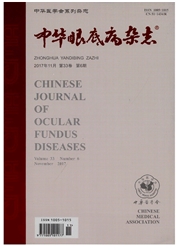

 中文摘要:
中文摘要:
目的 培养人视网膜微血管内皮细胞,建立人视网膜血管体外二维模型。方法 人视网膜血管内皮细胞在纤维连接蛋白包被的细胞培养池内,以无血清人内皮细胞培养基培养,形成二维血管模型。用辣根过氧化酶检测其通透性。部分血管模型加入5ng/ml的血管内皮生长因子培养,与无血管内皮生长因子培养形成的血管模型比较通透性的变化,观察血管内皮生长因子对血管通透性的影响。结果 2~4d左右内皮细胞亚融合形成网状血管样结构,6d左右形成较完整的二维血管模型。血管内皮生长因子可增大血管的通透性,促进血管生成。结论 用人内皮细胞培养基可成功培养人视网膜血管内皮细胞;利用细胞培养池和无血清人内皮细胞培养基培养,可建立标准的体外视网膜二维血管模型。
 英文摘要:
英文摘要:
Objective To cultivate human retinal capillary endothelial cells (HRECs) and establish two-dimensional model of human retinal vessels in vitro. Methods In a fihronectin-coated raising pound, HRECs were cultured by non-serum human-endothelial-cells suhstrate and two-dimensional model of human retinal vessels was established. Horseradish peroxidase was used to detect the permeability. Some of the vascular models were cultivated with 5 ng/ml vascular endothelial growth factor (VEGF), whose changes of permeability was compared with which of the models without cultivation with VEGF. The effect of VEGF on vascular permeability was observed. Results Meshy vascular structure came into being due to the confluent HRECs after 2 to 4 days. Comparatively complete two-dimensional vascular model after about 6 days. VEGF increased vascular permeability and promoted the formation of blood vessels. Conclusion HRECs can he cultivated successfully with human-endothelial-cells suhstrate; standard retinal two-dimensional vascular model in vitro can he established by using cellular raising pound and non-serum human-endothelial-cells suhstrate.
 同期刊论文项目
同期刊论文项目
 同项目期刊论文
同项目期刊论文
 期刊信息
期刊信息
